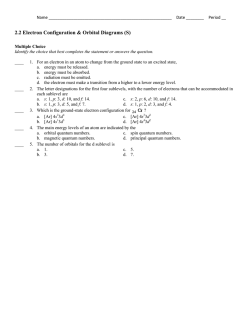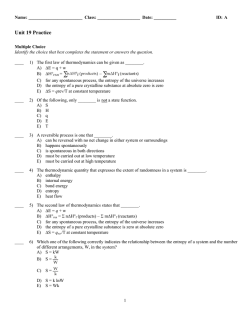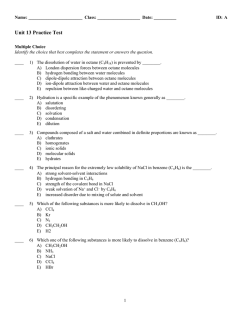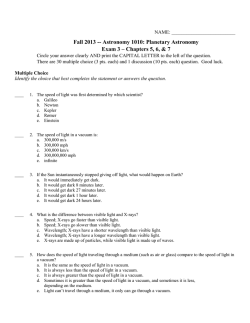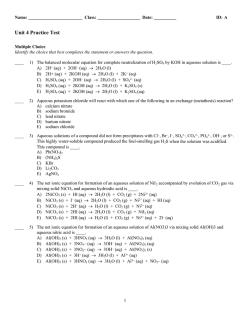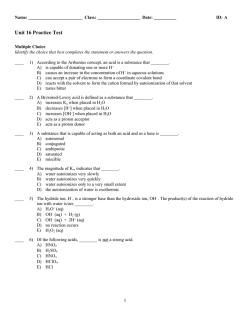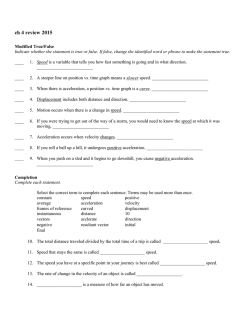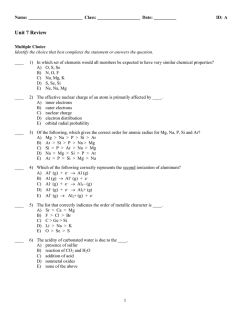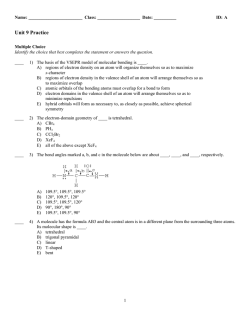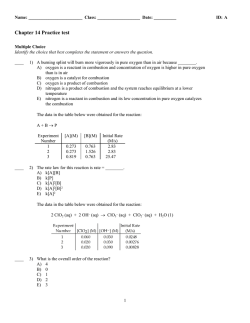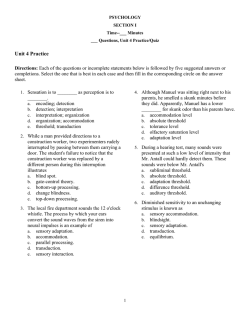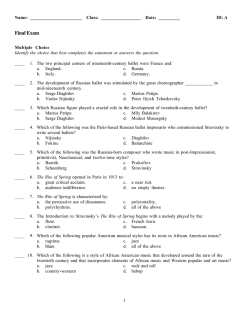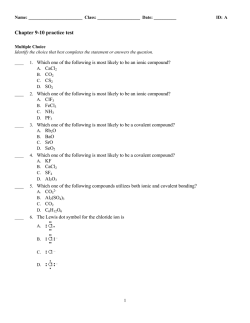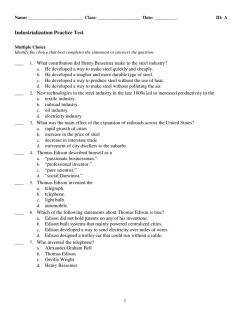
ExamView - Untitled.tst
Name: ________________________ Class: ___________________ Date: __________ Unit 15 Practice Test Multiple Choice Identify the choice that best completes the statement or answers the question. ____ 1) At equilibrium, ________. A) all chemical reactions have ceased B) the rates of the forward and reverse reactions are equal C) the rate constants of the forward and reverse reactions are equal D) the value of the equilibrium constant is 1 E) the limiting reagent has been consumed ____ 2) Which one of the following will change the value of an equilibrium constant? A) changing temperature B) adding other substances that do not react with any of the species involved in the equilibrium C) varying the initial concentrations of reactants D) varying the initial concentrations of products E) changing the volume of the reaction vessel ____ 3) The equilibrium constant for reaction 1 is K. The equilibrium constant for reaction 2 is ________. SO3 (g) (1) SO2 (g) + (1/2) O2 (g) (2) 2SO3 (g) 2SO2 (g) + O2 (g) A) B) C) D) E) ____ K2 2K 1/2K 1/K2 –K2 4) The Keq for the equilibrium below is 5.4 1013 at 480.0 °C. 2NO (g) + O2 (g) 2NO2 (g) What is the value of Keq at this temperature for the following reaction? NO2 (g) A) B) C) D) E) NO (g) + O2 (g) 5.4 10–13 5.4 1013 1.4 10–7 5.66 10–3 none of the above 1 ID: A Name: ________________________ ____ 5) Which of the following expressions is the correct equilibrium-constant expression for the reaction below? A) B) C) D) E) ____ ID: A 2SO2 (g) + O2 (g) [SO3] / [SO2][O2] [SO2] / [SO3] [SO3]2 / [SO2]2[O2] [SO3]2 / [SO2]2[O2]2 [SO3] / [SO2][O2]2 2SO3 (g) 6) The expression for Kp for the reaction below is ________. 4CuO (s) + CH4 (g) CO2 (g) + 4Cu (s) + 2H2O (g) A) B) C) D) E) ____ 7) The equilibrium constant for the gas phase reaction 2NH3 (g) N2 (g) + 3H2 (g) is Keq = 230 at 300 °C. At equilibrium, ________. A) products predominate B) reactants predominate C) roughly equal amounts of products and reactants are present D) only products are present E) only reactants are present ____ 8) Which of the following statements is true? A) Q does not change with temperature. B) Keq does not change with temperature, whereas Q is temperature dependent. C) K does not depend on the concentrations or partial pressures of reaction components. D) Q does not depend on the concentrations or partial pressures of reaction components. E) Q is the same as Keq when a reaction is at equilibrium. 2 Name: ________________________ ____ ID: A 9) In which of the following reactions would increasing pressure at constant temperature not change the concentrations of reactants and products, based on Le Châtelier's principle? A) N2 (g) + 3H2 (g) 2NH3 (g) 2NO2 (g) B) N2O4 (g) 2NO2 (g) C) N2 (g) + 2O2 (g) 2N2O (g) D) 2N2 (g) + O2 (g) 2NO (g) E) N2 (g) + O2 (g) ____ 10) Consider the following reaction at equilibrium. 2CO2 (g) 2CO (g) + O2 (g) H° = –514 kJ Le Châtelier's principle predicts that the equilibrium partial pressure of CO (g) can be maximized by carrying out the reaction ________. A) at high temperature and high pressure B) at high temperature and low pressure C) at low temperature and low pressure D) at low temperature and high pressure E) in the presence of solid carbon ____ 11) The value of Keq for the equilibrium H2 (g) + I2 (g) 2HI (g) is 54.0 at 427 °C. What is the value of K eq for the equilibrium below? HI (g) A) B) C) D) E) H2 (g) + I2(g) 27 7.35 0.136 2.92 103 3.43 10–4 ____ 12) A reaction vessel is charged with hydrogen iodide, which partially decomposes to molecular hydrogen and iodine: 2HI (g) H2(g) + I2(g) When the system comes to equilibrium at 425 °C, = 0.0960 atm. The value of Kp at this temperature is ________. A) 6.80 10–2 B) 1.30 10–2 C) 54.3 D) 1.84 10–2 E) Kp cannot be calculated for this gas reaction when the volume of the reaction vessel is not given. 3 Name: ________________________ ID: A ____ 13) A sealed 1.0 L flask is charged with 0.500 mol of I 2 and 0.500 mol of Br2. An equilibrium reaction ensues: I2 (g) + Br2 (g) 2IBr (g) When the container contents achieve equilibrium, the flask contains 0.84 mol of IBr. The value of K eq is ________. A) 11 B) 4.0 C) 110 D) 6.1 E) 2.8 ____ 14) At 200 °C, the equilibrium constant (K p) for the reaction below is 2.40 103. 2NO (g) N2 (g) + O2 (g) A closed vessel is charged with 36.1 atm of NO. At equilibrium, the partial pressure of O 2 is ________ atm. A) 294 B) 35.7 C) 17.9 D) 6.00 E) 1.50 10–2 ____ 15) Given the following reaction at equilibrium, if K p = 1.10 at 250.0 °C, Kc = ________. A) B) C) D) E) PCl5 (g) 3.90 10–6 2.56 10–2 1.10 42.9 47.2 PCl3 (g) + Cl2 (g) ____ 16) The value of Keq for the following reaction is 0.26: A (g) + B (g) C (g) + D (g) The value of Keq at the same temperature for the reaction below is ________. A) B) C) D) E) 2A (g) + 2B (g) 0.068 0.52 1.2 0.065 0.26 2C (g) + 2D (g) 4 Name: ________________________ ID: A ____ 17) At 1000.0 K, the equilibrium constant for the reaction 2NO (g) + Br2 (g) 2NOBr (g) is Kp = 0.016. Calculate Kp for the reverse reaction, A) B) C) D) E) 2NOBr (g) 0.016 1.6 10–4 63 0.99 1.1 2NO (g) + Br2 (g). ____ 18) Dinitrogen tetroxide partially decomposes according to the following equilibrium: N2O4 (g) 2NO2 (g) A 1.000-L flask is charged with 9.20 10–3 mol of N2O4. At equilibrium, 5.98 10–3 mol of N2O4 remains. Keq for this reaction is ________. A) 0.183 B) 0.197 C) 0.212 D) 6.94 10–3 E) 2.96 10–5 ____ 19) At 900.0 K, the equilibrium constant (K p) for the following reaction is 0.345. 2SO2 + O2 (g) 2SO3 (g) At equilibrium, the partial pressure of SO2 is 36.9 atm and that of O2 is 16.8 atm. The partial pressure of SO3 is ________ atm. A) 88.8 B) 3.89 10–3 C) 214 D) 5.57 10–4 E) 42.4 ____ 20) At 24° C, Kp = 0.080 for the equilibrium: NH4HS (s) NH3 (g) + H2S (g) A sample of solid NH4HS is placed in a closed vessel and allowed to equilibrate. Calculate the equilibrium partial pressure (atm) of ammonia, assuming that some solid NH4HS remains. A) 0.28 B) 0.080 C) 0.052 D) 0.0049 E) 3.8 5 Name: ________________________ ID: A ____ 21) The reaction below is exothermic: 2SO2 (g) + O2 (g) 2SO3 (g) Le Châtelier's Principle predicts that ________ will result in an increase in the number of moles of SO 3 (g) in the reaction container. A) increasing the amount of SO2 B) decreasing the pressure C) increasing the temperature D) removing some oxygen E) increasing the volume of the container ____ 22) Consider the following reaction at equilibrium: C (s) + H2O (g) CO (g) + H2 (g) Which of the following conditions will decrease the partial pressure of CO? A) decreasing the volume of the reaction vessel B) increasing the volume of the reaction vessel C) decreasing the amount of carbon in the system D) decreasing the pressure of the reaction vessel E) adding a catalyst to the reaction system 6 ID: A Unit 15 Practice Test Answer Section MULTIPLE CHOICE 1) ANS: OBJ: 2) ANS: OBJ: 3) ANS: OBJ: 4) ANS: OBJ: 5) ANS: OBJ: 6) ANS: OBJ: 7) ANS: OBJ: 8) ANS: OBJ: 9) ANS: OBJ: 10) ANS: OBJ: 11) ANS: OBJ: 12) ANS: OBJ: 13) ANS: OBJ: 14) ANS: OBJ: 15) ANS: OBJ: 16) ANS: OBJ: 17) ANS: OBJ: 18) ANS: OBJ: 19) ANS: OBJ: 20) ANS: OBJ: 21) ANS: OBJ: B 15.1; G2 A 15.2; G2 D 15.2; G2 C 15.2; G4 C 15.2; G2 C 15.4; G2 A 15.3; G4 E 15.6; G2 E 15.7; G2 C 15.7; G2 C 15.2; G4 D 15.5; G4 C 15.5; G4 C 15.6; G4 B 15.2; G4 A 15.2; G4 C 15.2; G4 D 15.5; G4 A 15.5; G4 A 15.5; G4 A 15.7; G2 PTS: 1 DIF: 1 REF: Page Ref: 15.1 PTS: 1 DIF: 2 REF: Page Ref: 15.2 PTS: 1 DIF: 4 REF: Page Ref: 15.2 PTS: 1 DIF: 2 REF: Page Ref: 15.2 PTS: 1 DIF: 2 REF: Page Ref: 15.2 PTS: 1 DIF: 2 REF: Page Ref: 15.2 | Page Ref: 15.4 PTS: 1 DIF: 1 REF: Page Ref: 15.3 PTS: 1 DIF: 3 REF: Page Ref: 15.6 PTS: 1 DIF: 4 REF: Page Ref: 15.7 PTS: 1 DIF: 3 REF: Page Ref: 15.7 PTS: 1 DIF: 2 REF: Page Ref: 15.2 PTS: 1 DIF: 3 REF: Page Ref: 15.5 PTS: 1 DIF: 3 REF: Page Ref: 15.5 PTS: 1 DIF: 4 REF: Page Ref: 15.6 PTS: 1 DIF: 3 REF: Page Ref: 15.2 PTS: 1 DIF: 4 REF: Page Ref: 15.2 PTS: 1 DIF: 2 REF: Page Ref: 15.2 PTS: 1 DIF: 3 REF: Page Ref: 15.5 PTS: 1 DIF: 3 REF: Page Ref: 15.5 PTS: 1 DIF: 4 REF: Page Ref: 15.5 PTS: 1 DIF: 3 REF: Page Ref: 15.7 1 ID: A 22) ANS: A OBJ: 15.7; G2 PTS: 1 DIF: 5 2 REF: Page Ref: 15.7 Unit 15 Practice Test [Answer Strip] C _____ 5) E _____ 9) ID: A C 13) _____ C 17) _____ B _____ 1) C 10) _____ C _____ 6) C 14) _____ A _____ 2) D 18) _____ C 11) _____ D _____ 3) B 15) _____ A 19) _____ A _____ 7) C _____ 4) A 16) _____ D 12) _____ A 20) _____ E _____ 8) Unit 15 Practice Test [Answer Strip] A 21) _____ A 22) _____ ID: A
© Copyright 2024
